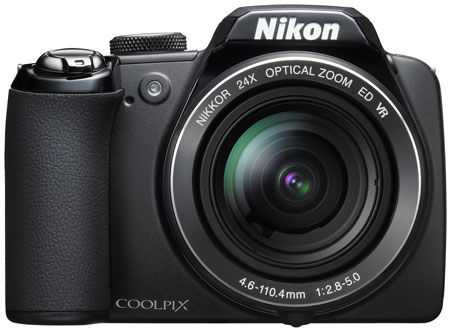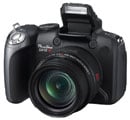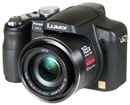Nikon COOLPIX P90
-
-
Written by Gordon Laing
Nikon COOLPIX P90 verdict
Nikon’s COOLPIX P90 is the latest in a steady stream of new super-zoom digital cameras, and looks promising from the outset with a longer range and higher resolution than many key rivals. With 12.1 Megapixels and a 24x optical zoom range, it out specifies both the Canon PowerShot SX10 IS and the Panasonic Lumix DMC-FZ28, which are leaders in this market. Indeed only the 26x zoom range of the Olympus SP-590UZ stops Nikon’s latest from claiming the crown of longest super-zoom on the market today. We’ve certainly come a long way from the days when 8 or 10x ranges were considered enormous.
In practice the COOLPIX P90’s optical range certainly impresses. While many rivals start at an equivalent of 28mm, the P90 kicks-off slightly wider at 26mm, and doesn’t stop zooming until it reaches a considerable 624mm. This provides enormous flexibility, capturing large landscapes, interiors or group shots at one moment, before zooming-in to grab distant detail.
The P90’s 3in tilting screen is also a nice addition and while it doesn’t fully articulate like Canon’s PowerShot SX10 IS, it will tilt downwards by 45 degrees or face directly upwards to help when composing at high or low angles.
 |
The build quality is excellent, and in our view, the P90’s balance in your hands and surface finish are the best of the current crop. There’s also some nice features including time-lapse movies, interval shooting and a high-speed continuous option. Rounding off the feature-set are up-to-date gadgets like scene, smile and even blink recognition.
But all is not well with the COOLPIX P90. Most super-zooms suffer from coloured fringing when zoomed-in, but the P90 has it worse than others and sadly doesn’t inherit the effective digital reduction found in Nikon’s latest DSLRs. More worryingly the overall image quality is marred by heavy processing which smears fine detail and overly-accentuates edges – you can see examples of this on our first results page. The bottom line is images from rivals like Canon’s PowerShot SX10 IS are simply more detailed and natural looking despite having two fewer Megapixels.
The movie mode is also disappointing with average quality and no optical zoom once you start filming. The time-lapse option is a neat bonus, but again models like the Canon SX10 IS simply offer much better quality video (and audio) to start with, along with optical zooming.
The P90’s Vibration Reduction certainly eliminated many wobbles, but we didn’t find it as consistently effective as the optical stabilisation on some rivals, and there’s the simple fact a maximum focal length of 624mm will still need a reasonable shutter speed to handhold, even with stabilisation on your side.
Additional issues include a coarse-looking screen image, scene and blink recognition not working as seamlessly as rivals, a lens cap that has to be removed before powering-up and a relatively short battery life. In short, while there’s a number of good aspects about the P90, it disappoints in many others – and crucially there are several alternative models which simply out-perform it. So before wrapping-up, how does it compare to the best super-zooms on the market today?
Compared to Canon PowerShot SX10 IS
 |
Canon’s PowerShot SX10 IS has become one of the best-selling cameras in any category and is the model any new super-zoom has to measure-up to. Costing roughly the same as the Nikon COOLPIX P90, it’s inevitably the model most people will be weighing-up against it.
In its favour, the SX10 IS has a better-looking (albeit smaller) screen that’s fully-articulated to face in almost any direction. Its optical zoom range may be slightly shorter, but you can optically adjust it while filming video and the cap won’t block the lens as it extends during power-up. The movie mode delivers better image quality, along with cleaner sound that’s also in stereo. The flash may not popup as high, but behind it is a fully-featured hotshoe for mounting external Speedlite flashguns. There’s a quick and easy super-imposed function menu offering quick access to the main settings. In our tests, the SX10 IS’s image quality was noticeably superior to the P90 with finer detail and a more natural-looking appearance. And while you may or may not like the SX10 IS’s use of AA batteries, there’s no denying a set lasts longer than the P90’s pack.
In its defence, the P90 features a number of benefits, but in practice most come with caveats. The optical zoom range is a little wider and longer, but it doesn’t make a huge difference to the Canon’s 20x range, and suffers from worse fringing when zoomed-in. The resolution is two Megapixels higher, but we didn’t measure any greater real-life detail in practice. The screen is bigger at 3in, but looks coarse. In terms of real benefits, the P90 is lighter, while boasting time-lapse movies, interval shooting and a fast continuous shooting option, along with scene, smile and blink detection.
A handful of features aside though, the P90 is comfortably out-performed by the Canon in the core respects of still shooting and video recording. As such it will be preferred by most, although do also compare it to the Panasonic FZ28 below. For more details on the Canon, see our PowerShot SX10 IS review and video tour
Compared to Panasonic Lumix DMC-FZ28
 |
Panasonic’s Lumix DMC-FZ28 is another big-seller in the super-zoom market and a key rival for any new model. It may have the shortest optical zoom range of the current crop, but 18x still isn’t to be sniffed at and the camera features a number of benefits over the P90.
In its favour, the Lumix FZ28 is smaller and lighter, features RAW recording, 720p HD movies, optical zooming while filming video, a slightly smaller but better-looking screen, in-camera reduction of coloured fringing, an optional component output to HDTVs, longer battery life, more effective scene recognition and a quick and easy super-imposed quick menu system. In our tests we also found the FZ28’s photo and video quality was preferred.
It’s not all one-sided though. The COOLPIX P90 zooms slightly wider and comfortably longer, has two extra Megapixels, a larger tilting screen and features like time-lapse movies, interval shooting along with smile and blink detection.
Most will find the FZ28’s benefits outweigh any advantages of the P90 though, and crucially it costs around 25% less. As such it’s one of the most compelling super-zooms around today and should be on anyone’s shortlist along with the Canon SX10 IS. See our Panasonic Lumix DMC FZ28 review for more details.
Also consider
If you’re in the market for a super-zoom, also consider the Olympus SP-590UZ which sports the longest optical zoom range of all at the time of writing: a whopping 26x. If your budget can stretch, two additional models swap the traditional CCD sensor for CMOS chips, not to improve image quality, but to greatly accelerate continuous shooting at the full resolution along with delivering HD movies.
Canon’s PowerShot SX1 IS was the first to do so, boasting 1080p video and 4fps at the full 10 Megapixel resolution, although Sony’s forthcoming Cyber-shot DSC-HX1 trumps this speed with nothing less than 9fps shooting – a fair trade given its slightly lower resolution of 9 Megapixels. See our Canon PowerShot SX1 IS review for more details.
Nikon COOLPIX P90 final verdict
Viewed in isolation, Nikon’s COOLPIX P90 is a fairly decent camera. It features one of the longest optical zoom ranges on the market, a large tilting monitor for creative composition, and a number of neat gadgets in addition to simply feeling good in your hands. If it were the only super-zoom camera you’d used of the current crop, you could be pretty happy with it.
But, and it’s a big but, there are simply better models out there, most notably Canon’s PowerShot SX10 IS and Panasonic’s Lumix DMC-FZ28. Neither match the sheer optical range of the P90, but both comfortably outperform it with superior quality, along with a number of other key advantages described above.
In the face of such tough rivals, it’s hard to recommend the COOLPIX P90 over them. Don’t get us wrong – it’s a fairly decent camera with a number of unique capabilities which are reflected in our scores below, but in our view there are simply better super-zooms available right now.
Bad points | Scores (relative to 2009 super-zooms) | |||
Build quality: Image quality: Handling: Specification: Value:
Overall: |
18 / 20 14 / 20 17 / 20 17 / 20 15 / 20
81% | |||



